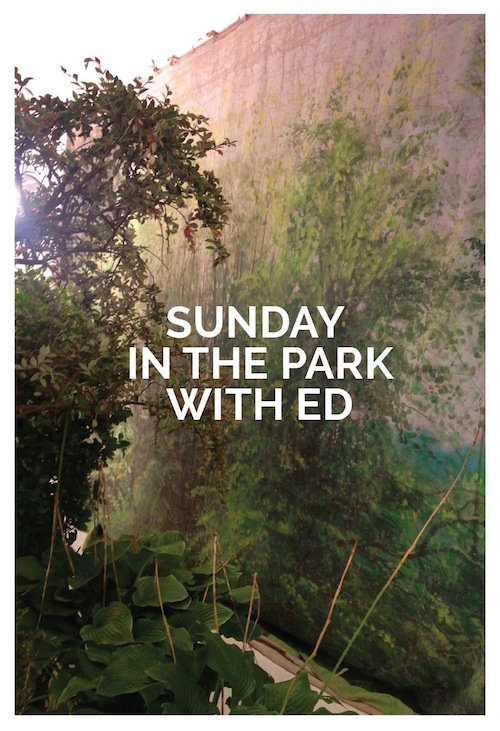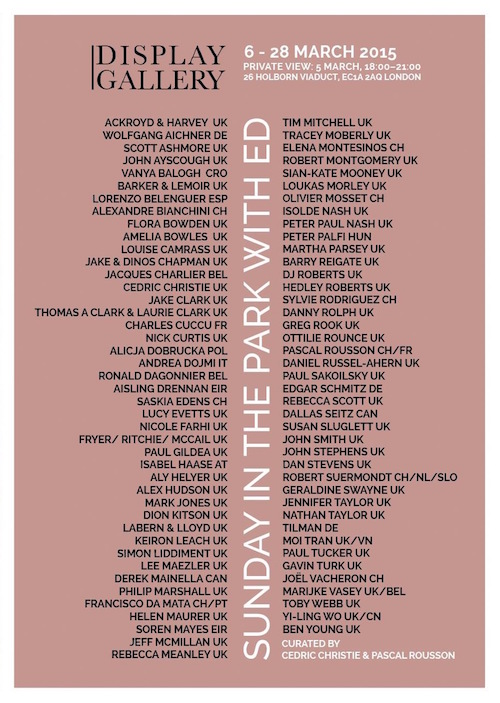6 - 28 March 2015
Display Gallery
28 Holborn Viaduct
London EC1A 2AQ
Text-Me-Up-Sex-Drugs & Rock'n'Roll has taken a decade to create. 'Howard Marks' is one in the series of six text messages which makes up the full exhibition of cross-stitched embroideries based on the main title. Using the mobile phone as my pallet this work focuses on the cult of the celebrity transgressing the moral and social boundaries of my personal text messages - in turn creating a detailed permanence from a slice of cultural history that would be otherwise have been lost in the ether...
Tracey Moberly - Artist, Author & Activist. An associate lecturer at UAL, she lectures in both Art and Politics. Practicing as a Socio-Political Artist. Recent exhibitions: Sheffield Millennium Gallery; Tate Modern (The Tanks) & Tate Britain. Her last book 'Text-Me-Up!' is based on saving every text she's ever received - which she has continued to do.
DISPLAY GALLERY
presents
SUNDAY IN THE PARK WITH ED
curated by Cedric Christie & Pascal Rousson
6th – 28th March 2015
Private View 5th March 6-9pm
https://www.flickr.com/photos/130614624@N03/sets/
Display Gallery is pleased to present Sunday in the Park with Ed, curated by Cedric Christie & Pascal Rousson. Taking Édouard Manet’s Le Déjeuner sur l’Herbe as a starting point, the show asks artists to look at what is transgressive in their own practice, questioning whether the radicalism present in Manet's work has been truly taken forward. The show features over 80 artists, with a focus on painting and European artists. The show also includes a picnic installation where a series of guests have been invited to host evening picnics. Artists include Ackroyd & Harvey, Jake & Dinos Chapman, Jacques Charlier, Simon Liddiment, Robert Montgomery, Martha Parsey, Barry Reigate, Danny Rolph, John Smith, Geraldine Swayne, Gavin Turk, Marijke Vasey & Ben Young.
Ackroyd & Harvey UK/ Wolfgang Aichner DE/ Michael Ashcroft UK/ Scott Ashmore UK/ John Ayscough UK/ Vanya Balogh CRO/ Lorenzo Belenguer ESP/ Alexandre Bianchini CH/ Flora Bowden UK/ Amelia Bowles UK/ Louise Camrass UK/ Jake & Dinos Chapman UK/ Jacques Charlier BEL/ Cedric Christie UK/ Jake Clark UK/ Thomas A Clark & Laurie Clark UK/ Charles Cuccu FR/ Nicholas Curtis UK/ Alicja Dobrucka POL/ Andrea Dojmi IT/ Ronald Dagonnier BEL/ Aisling Drennan EIR/ Saskia Edens CH/ Lucy Evetts UK/ Nicole Farhi UK/ Alex Fox UK/ Fryer, Ritchie, McCail UK/ Paul Gildea UK/ Isabel Haase AT/ Aly Helyer UK/ Hoax & Akarat UK/ Alex Hudson UK/ Mark Jones UK/ Dion Kitson UK/ Labern & Lloyd UK/ Keiron Leach UK/ Simon Liddiment UK/ Lee Maelzer UK/ Derek Mainella CAN/ Philip Marshall UK/ Francisco Da Mata CH,PT/ Helen Maurer UK/ Soren Mayes EIR/ Jeff McMillan UK/ Rebecca Meanley UK/ Tim Mitchell UK/ Tracey Moberly UK/ Elena Montesinos CH/ Robert Montgomery UK/ Sian-Kate Mooney UK/ Loukas Morley UK/ Olivier Mosset CH/ Isolde Nash UK/ Peter Palfi HUN/ Martha Parsey UK/ Toby Rainbird-Webb UK/ Barry Reigate UK/ DJ Roberts UK/ Hedley Roberts UK/ Sylvie Rodriguez CH/ Danny Rolph UK / Greg Rook UK/ Colin J Ross UK/ Ottilie Rounce UK/ Pascal Rousson CH,FR/ Daniel Russel-Ahern UK/ Paul Sakoilsky UK/ Edgar Schmitz DE/ Rebecca Scott UK/ Dallas Seitz CAN/ Susan Sluglett UK/ John Smith UK/ John Stephens UK/ Dan Stevens UK/ Robert Suermondt CH,NL,SLO/ Geraldine Swayne UK/ Jennifer Taylor UK/ Nathan Taylor UK/ Tilman DE/ Moi Tran UK,VN/ Paul Tucker UK/ Gavin Turk UK/ Joël Vacher n CH/ Marijke Vasey BEL/ Yi-Ling Wo UK,CN/ Ben Young UK,USA
please direct press requests and requests for hi-quality images to Caroline Minar at Display Gallery caroline@displaygallery.co.uk for sales enquiries contact Josefina Pierucci josefina@displaygallery.co.uk a gallery of images is available at www.flickr.com/photos/130614624@N03/sets/
gallery opening hours Tues to Sat 12 to 6pm; Wed 12 to 8pm or by appointment Display Gallery, Holborn Viaduct, London EC1A 2AQ +44 (0)7795 393493 www.displaygallery.co.uk
According to curator Pascal Rousson “This is an artist show made by practising artists. When Manet exhibited Le Déjeuner sur l’Herbe at the Salon des Refusés in 1863, the state was pretty much the only art ‘commanditaire’ (patron) and dictating public taste was a form of aesthetic dictatorship. Manet was to turn things upside down, all would soon drasti- cally change with Impressionism when artists began exhibiting independently from the state. So our idea was to have a ‘salon des indépendants’, as it used to be called, just between artists, to open a discussion through the works and artist talks to ask if something remotely close to the avant garde still existed. It was obvious for us to choose Le Déjeuner as a start- ing point: it’s hard to understand how revolutionary and heretically scandalous it was when it now seems quite harmless. We’re attempting to ask each artist if they think it’s possible to still achieve something equivalent. If not, are we, as in the 1860s, back in an absolute aesthetic dictatorship? Co-curator Cedric Christie adds: “It’s that thing that Zola talked about when he was describing contemporary taste: “They can't stand strong truths. There is no one to guide the crowd, and what can they do in the great hubbub of contemporary opinions? Art is fragmented ... Each artist has drawn the crowd to himself, flattered it, given it the playthings it loves, gilded and decorated with pink ribbons. Art here has thus become a vast boutique of sweets, with candies for all tastes”. A ‘vast boutique of sweets’ – I love that. It seemed so familiar, what has changed? We wanted to put it to the test.”
For the figurative painters with a direct relationship to Manet, the question is perhaps more straight- forward. Geraldine Swayne explains “I paint ordinary people and sometimes even marginal ones, but this isn't radical in the hard-left sense of Zola's journalism or Manet's experiments but it's a bit radical in its fundamentalism, i.e. nudging sludge around till it looks like something else. As to transgression or violation of moral boundaries, I don't care if I do, and don't think relativism should creep into artists’ choices. Aniconism alone is enough to have had artists be put to death recently, so I will continue to exercise my right, as Manet did, to paint us as we are: laughing, frowning, fucking, praying etc, for as long as I want”. For Mark Jones it’s personal: “I still find Manet’s painting radical. If you compare it to the Salon painting of the time it’s mind blowing. Really his work is a natural develop- ment from Velasquez or Titian. To transgress I have to overstep some notion of what is expected from a representa- tional painting now. My whole painting practice is based on Manet - his subjects are always in role-play and in some way self-conscious or separate from the life to the point of alienation. I don’t set out to be transgressive, just raw and direct”. Derek Mainella, the Canadian artist writes: “I always think of Manet as the last great painter (of representational things) and also the first modern one, with Le Dejeuner sur l’Herbe standing as one of the greatest paintings of all time. It’s significance as a key avant-garde moment in art history is not to be denied, however there are also the more contemporary issues of its problematic gaze. My work for this show is co-incidentally subtitled ‘the modern gaze’, as it explores this not dissimilar relationship of modern painting to the society in which it is created. The gaze now shifted to and from phones and computer screens - a new digital reality, which, for better or worse, slowly draws our focus from human interaction and real problems”
That relationship with society, the role of the avant-garde, is something that preoccupies Ackroyd & Harvey, who recently withdrew Living Skin from a touring show after questioning and confronting political actions of the sponsor: “Today, funding cuts and austerity measures put corporate sponsorship and individual philanthropy under a spotlight, and throws into shadow often uncomfortable, uncertain, and unexpected issues confronted by the artist. The question is whether the avant-garde is indeed the ‘immediate and fastest way’ to sustained social and environmental reform or a malleable and effective tool for corporate branding and political sani- tization?” Ackroyd & Harvey will also be giving an exhibition talk on the history of this work.
As for artists dealing with abstraction, Simon Liddiment reckons that “the transgressive in art only exists in pock- ets – of ignorance and forgetfulness”; Danny Rolph quotes de Kooning: “When I'm falling, I am doing all right. And when I am slipping, I say, 'Hey this is very interesting'. It is when I am standing upright that bothers me. I'm not doing so good. I'm stiff, you know ... As a matter of fact, I'm really slipping most of the time into the glimpse. That is a wonderful sensation, I realize right now, to slip into this glimpse. I'm like a slipping glimpser”. For Ben Young, “the work I'm exhibiting transgresses the fundamentals of previous work by denying overt narrative - it's not 'about' anything. Any narrative significance there might be resides solely in the choice of materials and build up of the painting's surface. It takes as its subject my unkempt backyard in Italy - so is it a (square) land- scape painting or a non-representational abstraction that borrows its palette from the colours and tones of a snow-covered yard? There’s no clear answer. I almost prefer it to be taken as a three dimensional object that happens to be covered in paint.”
As well as Gavin Turk and Jake & Dinos Chapman, the show includes multi-disciplinary Belgian artist Jacques Charlier (b. 1939), whose project 100 sexes d'artistes was rejected by the Venice Biennale in 2009. Olivier Mosset (Swiss, b.1944), known for his monochrome works and influence on the Neo-Geo painters of the 80s and the avant garde filmmaker John Smith. Artists also include Robert Montgomery exhibiting one of his poetic billboard pieces, Barry Reigate maker of ‘pop porn’ works, and Martha Parsey and Marijke Vasey who are both showing paintings dealing with the question of the representation of the female image.
Rousson, who is Swiss French, concludes: “Mostly we selected fellow artists with whom we’ve done collaborative work, exhibited, or talked to during studio visits and exhibitions. They came from lots of creative backgrounds and seemed to be able to make an interesting comment about the topic of the avant garde today - its legacy seems a major concern, with large amounts of work dealing with art references, nostalgia, etc. Many appear to ask if we have reached a dead end? What can still be done? We don’t really know what we’re finally going to end up with in terms of questions or answers expressed by the works. During our install week, we’ll try to make sense of it all, a bit like experimenting in your studio. Let’s wait and see.”
please direct press requests and requests for hi-quality images to Caroline Minar at Display Gallery caroline@displaygallery.co.uk for sales enquiries contact Josefina Pierucci josefina@displaygallery.co.uk
gallery opening hours Tues to Sat 12 to 6pm; Wed 12 to 8pm or by appointment Display Gallery, Holborn Viaduct, London EC1A 2AQ +44 (0)7795 393493 www.displaygallery.co.uk

